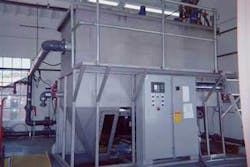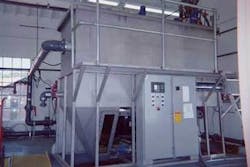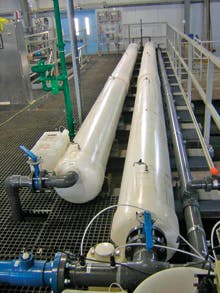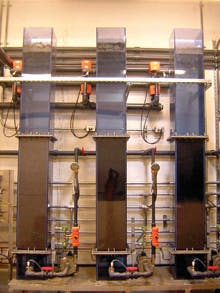Permanent Pilot Plants: Let Your Pilot Be Your Pilot
by Bruce Long, Bob Hulsey, and Nick Burns
Water utility managers have tremendous responsibility as they steer their systems through numerous and increasingly difficult challenges. They must comply with the expanding array of regulatory requirements; provide an aesthetically satisfying product that is free of tastes, odors, and the potential for discoloration; and meet the growing demand as well as more sophisticated expectations of their customers. And of course they must accomplish all of this in the most cost-efficient manner.
To help determine the best means to meet these goals, many utilities are constructing and operating permanent pilot plant facilities. Pilot plants in the water treatment industry have traditionally been temporary facilities used to conduct studies or experiments, test new or upgraded processes, and evaluate alternative operating conditions. But an increasing number of water utilities have discovered the abundant benefits derived from installing and operating a permanent pilot plant as a component of full-scale facilities. Those utilities have discovered that a permanent pilot plant can be used to set direction and “pilot” their operations.
Depending on the treatment processes included, permanent pilot plants range in size from a few gallons per minutes to several hundred gallons per minute. Most utilities use permanent pilot plants to mimic the entire treatment plant -from pretreatment through filtration, disinfection, and even extending into the distribution system in some cases. Others construct facilities using a phased approach. For example, they may construct filter columns but also dedicate space for pretreatment facilities.
Pilot plants are an effective, responsible means of quickly assessing the impact(s) of process changes and operating enhancements before implementing them on a full-scale basis. It is a bit like giving a new car a “test spin” before taking it out on the highway for a long trip. A pilot plant can prove valuable not only to verify projected outcomes of operational changes, but also to identify unanticipated adverse outcomes. Such outcomes include finished water corrosivity, changes in sludge treatability characteristics and volumes produced, and improved removal of organic carbon at the expense of filtered water turbidity or filter productivity.
All too often, the quality of raw water entering a recently commissioned water treatment train differs substantially from that experienced during initial pilot plant testing. It may even be outside the range of water quality encountered during pilot tests. A permanent pilot plant provides an effective means of evaluating operating conditions that may not have been considered necessary to include in initial pilot testing in order to obtain satisfactory results.
It’s essential for operations staff to understand how plant processes respond to changes in raw water quality and how to modify operations to adapt to those changes. Use of permanent pilot plants for hands-on training of plant personnel not only prepares them to effectively respond to potential changes in raw water quality, but also provides satisfaction and confidence as a result of participating in the development of best operating ranges when faced with changes in source water. The result is improved morale and continued focus on achieving the targeted product water quality within prescribed treatment cost ranges.
Water utilities are expected to meet concurrent demands for increased as well as higher-quality supply at the lowest possible cost. Operating existing processes at higher rates, provided that plant hydraulics can accommodate higher flows, is typically an attractive, economical approach to satisfying the demand for greater volumes. However, it is imperative to demonstrate the continued effectiveness of individual unit processes as well as of the entire treatment train when facilities are operated at higher loading rates.
Results from permanent pilot plants provide critical information that can be used by regulatory agencies for review and approval of a utility’s petition to operate at higher production rates. Furthermore, spiking the raw water entering a pilot plant with challenge contaminants is a manageable method by which utilities can determine the effectiveness of treatment under changing influent quality conditions.
Process performance evaluations at increased loading rates are typically performed over a couple of months, which restricts the assessment of changes in raw water quality to only those conditions that occurred during the testing period. Permanent pilot plants make it possible to conduct such evaluations over a more extended period, thereby capturing a broader range of raw water quality. They also offer the opportunity to evaluate plant performance during specific episodes of unusual raw water quality conditions.
A final benefit of a permanent pilot plant is the increased opportunity for customer education. Pilot units can be constructed from transparent materials such as PVC, glass, acrylic, or Plexiglas - or they can be equipped with viewing ports - to enable interested customers, students, and other potential visitors to see how individual treatment processes work. Customer education events provide an excellent opportunity to showcase a utility’s commitment to supplying high-quality finished water with optimized chemical use and at the lowest possible operating cost.
Commitment Required
Given that permanent pilot plants offer multiple benefits, why don’t all utilities have them? One reason may be that it takes commitment to make this addition. This commitment ranges from funding the capital cost and providing sufficient resources for continued operation and maintenance of a permanent pilot plant to finding operators of the right personality type to take on the task of championing its use in order to optimize the full-scale plant.
Another consideration is that the extensive data generated by a permanent pilot plant can swamp pilot plant operators who must read the data manually. Although connecting the pilot plant to the full-scale plant’s SCADA system can be justified in most cases, an operator’s workload increases even if operating data is recorded automatically. This is because it takes time and dedicated staff to marry the operating data from the pilot plant with the results from laboratory water quality analyses to evaluate how the alternative operating conditions tested affect finished water characteristics and operating costs. Extra effort must also be expended to develop a testing protocol to guide the pilot plant’s operation and define how test data will be presented and interpreted.
All in all, however, a properly constructed and operated permanent pilot plant offers numerous water quality benefits, heightened staff focus on improved operation, and cost savings associated with optimized treatment. These advantages more than justify the commitment necessary for a water utility to make a pilot its pilot.
About the Authors
Bruce Long is a vice president and the Global Water Practice and Technology Leader for the water business of Black & Veatch Corporation. Bob Hulsey, P.E., is Director of Water Treatment Technology and Nick Burns, P.E. is a Water Process Engineer with Black & Veatch. All three authors are based in the company’s Kansas City, MO, headquarters office.



